Module 18 - Radar PrinciplesPages
i,
1-1, 1-11,
1-21,
1-31,
1-41,
2-1,
2-11,
2-21,
2-31,
2-41,
3-1,
3-11,
3-21,
4-1,
4-11,
4-21,
AI-1,
AII-1,
Index-1 to 3
(spark gaps)
connected in a microwave circuit with three terminal transmission lines, one each for the transmitter, receiver,
and antenna. As shown in views a and B of figure 2-12, these circuits may be connected in parallel or in series.
Both systems will be discussed in detail in this section. One tube is called the TRANSMIT-RECEIVER TUBE, or TR
TUBE; the other is called the ANTITRANSMIT- RECEIVE TUBE, or ATR TUBE. The TR tube has the primary function of
disconnecting the receiver, and the ATR tube of disconnecting the transmitter. 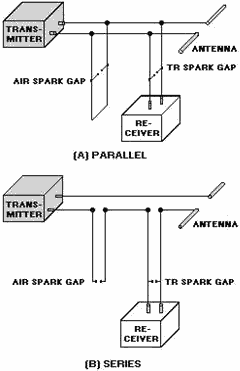
Figure 2-12. - Duplexer systems. The overall action of the TR and ATR circuits depends upon the impedance characteristics of the
quarter-wavelength section of transmission line. a quarter-wavelength, or an odd multiple of the quarter-
wavelength, transmission line presents opposite impedance values at the ends; one end of the line appears as a
short and the other end appears as an open. TR Tube The type of spark gap used as a TR
tube may vary. It may be one that is simply formed by two electrodes placed across the transmission line; or it
may be one enclosed in an evacuated glass envelope with special features to improve operation. The requirements of
the spark gap are (1) high impedance prior to the arc and (2) very low impedance during arc time. At the end of
the transmitted pulse the arc
2-21
should be extinguished as rapidly as possible. Extinguishing the arc stops any loss caused by the arc
and permits signals from nearby targets to reach the receiver. The simple gap formed in air has a
resistance during conduction of from 30 to 50 ohms. This is usually too high for use with any but an open-wire
transmission line. The time required for the air surrounding the gap to completely deionize after the pulse
voltage has been removed is about 10 microseconds. During this time the gap acts as an increasing resistance
across the transmission line to which it is connected. However, in a TR system using an air gap, the echo signals
reaching the receiver beyond the gap will be permitted to increase to half their proper magnitude 3 microseconds
after the pulse voltage has been removed. This interval is known as RECOVery TIME. Tr tubes are usually
conventional spark gaps enclosed in partially evacuated, sealed glass envelopes, as shown in figure 2-13. The arc
is formed as electrons are conducted through the ionized gas or vapor. You may lower the magnitude of voltage
necessary to break down a gap by reducing the pressure of the gas that surrounds the electrodes. Optimum pressure
achieves the most efficient TR operation. You can reduce the recovery time, or DEIONIZATION TIME, of the gap by
introducing water vapor into the TR tube. a TR tube containing water vapor at a pressure of 1 millimeter of
mercury will recover in 0.5 microseconds. It is important for a TR tube to have a short recovery time to reduce
the range at which targets near the radar can be detected. If, for example, echo signals reflected from nearby
objects return to the radar before the TR tube has recovered, those signals will be unable to enter the receiver. 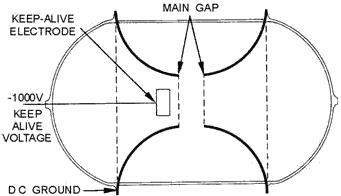
Figure 2-13. - TR tube with keep-alive electrode. Tr tubes used at microwave frequencies are built to fit into, and become a part of, a resonant cavity.
You may increase the speed with which the gap breaks down after the transmitter fires by placing a voltage across
the gap electrodes. This potential is known as KEEP-ALIVE Voltage and ranges from 100 volts to 1,000 volts. a glow
discharge is maintained between the electrodes. (The term GLow DIsCHARGE refers to the discharge of electricity
through a gas-filled electron tube. This is distinguished by a cathode glow and voltage drop much higher than the
gas-ionization voltage in the cathode vicinity.) This action provides for rapid ionization when the transmitter
pulse arrives.
Failure of the TR tube is primarily caused by two factors. The first and most common cause of failure is
the gradual buildup of metal particles that have been dislodged from the electrodes. Such metal bits become
spattered on the inside of the glass envelope. These particles act as small, conducting areas and tend to lower
the Q of the resonant cavity and dissipate power. If the tube continues in use for too long a 2-22
period in this condition, the particles will form a detuning wall within the cavity and eventually
prevent the tube from functioning. a second cause of failure is the absorption of gas within the enclosure by the
metal electrodes. This results in a gradual reduction of pressure within the tube to a point where gap breakdown
becomes very difficult. The final result is that extremely strong signals (from the transmitter) are coupled to
the receiver. Because both types of failures develop gradually, the TR tube periodically must be checked carefully
to determine performance level.
Q27. What type of switches are used as duplexers? Q28. What tube in a duplexer has the primary
function of disconnecting the receiver? Q29. How may the TR tube ionization speed be increased?
ATR Tube The ATR tube is usually a simpler device than a TR tube. An ATR tube might use a pure inert gas, such as argon, because recovery time generally is not a vital factor. Furthermore, a priming
agent, such as keep- alive voltage, is not needed. The absence of either a chemically active gas or a keep-alive
voltage results in ATR tubes having longer useful lives than TR tubes. Warning Tr and ATR tubes may contain radioactive material. Handle with care to avoid breakage and possible
contamination.
There are two basic tr-atr duplexer configurations. They are the parallel-connected and the series-
connected duplexer systems. The following paragraphs describe the operation of both systems.
Parallel Connected Duplexer Operation First, let's consider a PARALLEL-CONNECTED DUPLEXER system, as
shown in figure 2-14. The TR spark gap shown in figure 2-14 is located in the receiver coupling line one-quarter
wavelength from the T-junction. a half-wavelength, closed-end section of transmission line, called a STUB, is
shunted across the main transmission line. An ATR spark gap is located in this line one-quarter wavelength from
the main transmission line and one-quarter wavelength from the closed end of the stub. As shown in the figure,
antenna impedance, line impedance, and transmitter output impedance, when transmitting, are all equal. The action
of the circuit during transmission is shown in figure 2-15. 2-23

Figure 2-14. - Parallel-connected duplexer showing distance and impedance. 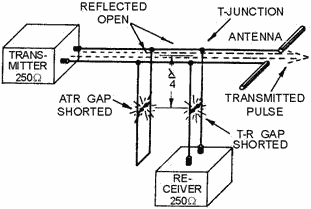
Figure 2-15. - Parallel-connected duplexer during transmission. During the transmitting pulse, an arc appears across both spark gaps and causes the TR and ATR circuits
to act as shorted (closed-end) quarter-wave stubs. The circuits then reflect an open circuit to the TR and ATR
circuit connections to the main transmission line. None of the transmitted energy can pass through these reflected
opens into the ATR stub or into the receiver. Therefore, all of the transmitted energy is directed to the antenna. During reception, as shown in figure 2-16, the amplitude of the received echo is not sufficient to cause an arc
across either spark gap. Under this condition, the ATR circuit now acts as a half-wave transmission line
terminated in a short-circuit. This is reflected as an open circuit at the receiver T-junction, three-quarter
wavelengths away. The received echo sees an open circuit in the direction of the transmitter. However, the
receiver input impedance is matched to the transmission line impedance so that the entire received signal will go
to the receiver with a minimum amount of loss.
2-24
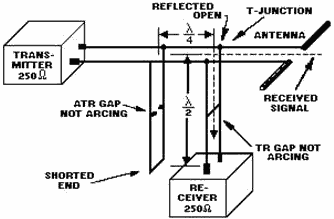
Figure 2-16. - Parallel-connected duplexer during reception. Series-Connected Duplexer Operation In the Series-CONNECTED DUPLEXER System, shown
in figure 2-17, the TR spark gap is located one-half wavelength from the receiver T-junction. The ATR spark gap is
located one-half wavelength from the transmission line and three-quarters wavelength from the receiver T-junction.
During transmission, the TR and ATR gaps fire in the series-connected duplexer system, as shown in figure 2-18.
This causes a short-circuit to be reflected at the series connection to the main transmission line one- half
wavelength away. The transmitted pulse "sees" a low impedance path in the direction of the antenna and does not go
into the ATR stub or the receiver.
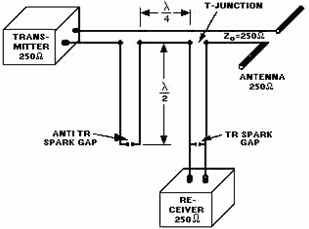
Figure 2-17. - Series-connected duplexer showing distance and impedance.
2-25
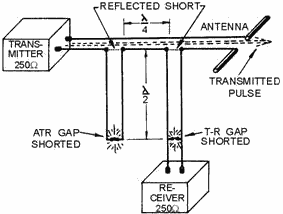
Figure 2-18. - Series-connected duplexer during transmission. During reception, neither spark gap is fired, as shown in figure 2-19. The ATR acts as a half-wave stub
terminated in an open. This open is reflected as a short-circuit at the T-junction three-quarters of a wavelength
away. Consequently, the received signal sees a low impedance path to the receiver, and none of the received signal
is lost in the transmitting circuit. 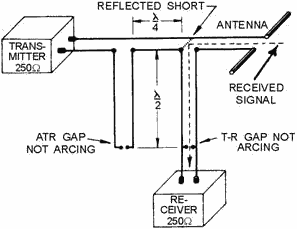
Figure 2-19. - Series-connected duplexer during reception. DUPLEXER TYPES Duplexers are constructed in many forms, such as RESONANT-CAVITY COAXIAL
Systems, WAVEGUIDE Systems, and HYBRID RINGS. Since waveguide and hybrid-ring duplexers are most common in radar
systems, those will be discussed in this section. 2-26
Waveguide Duplexer WAVEGUIDE DUPLEXERS usually consist of TR tubes and ATR tubes
housed in a resonant cavity and attached to a waveguide system in some manner. Resonant-cavity TR tubes may be
applied to waveguides, either directly or indirectly, to obtain switching action. The indirect method uses a
coaxial line system, and then couples the coaxial line into the waveguide that feeds the antenna. If large losses
are incurred by the use of a coaxial line, the resonant cavity can be coupled directly to the waveguide. Figure
2-20 shows a direct method of cavity TR switching in a waveguide system. The waveguide terminates in the antenna
at one end and in a shorting plate at the other. The magnetron uses a voltage probe to excite the waveguide. The
transmitted pulse travels up the guide and moves into the TR box through a slot. The cavity builds up a strong
electric field across the gap, breaks it down, and detunes the cavity. This action effectively seals the opening
and passes the pulse energy to the antenna.

Figure 2-20. - Waveguide duplexer with cavity TR tube. The signals received during the resting time travel down the guide to the magnetron and the shorting end
plate where they are reflected. The slot coupling the waveguide to the cavity is located at a point where the
standing-wave magnetic field produced by reflections in the waveguide is maximum. The maximum magnetic field,
therefore, energizes the cavity. The echo signals are not strong enough to cause an arc, and the cavity field is
undisturbed by the gap. Therefore, the cavity field couples RF energy into the receiver coaxial line and provides
maximum energy transfer. The cavity TR switch can also be applied to branch lines of the waveguide, as
shown in figure 2-21. The magnetron is coupled to the guide by a voltage probe to produce proper excitation. 2-27
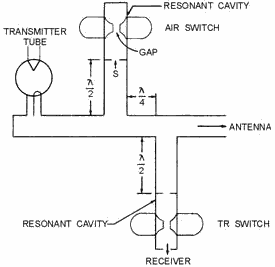
Figure 2-21. - Branched waveguide duplexer. Maximum use of the received signals is ensured by an ATR tube. The transmitted pulse travels from the
magnetron to the ATR branch where part of the energy is diverted into the gap. a slot (S) is placed across the
waveguide one-half wavelength from the main guide, and passes the RF energy through it and into the cavity. The
cavity builds up the electric field that breaks down the gap, detunes the cavity, and, as a result, effectively
closes the slot. One-half wavelength away, this action effectively closes the entrance to the ATR branch and
limits the amount of energy entering the ATR branch to a small value. Most of the energy is, therefore,
directed down the guide to the antenna. Upon reaching the receiver branch, the same effect is produced by the TR
tube in the receiver line. Because the energy entering both openings is effectively limited by the gaps, maximum
energy is transferred between the magnetron and the antenna. During the resting time, the ATR spark gap is
not broken down by the received signals. The received signal sets up standing waves within the cavity that cause
it to resonate. At resonance, the low impedance of the ATR cavity is reflected as a high impedance at the entrance
to the transmitter waveguide (three- quarter wavelength away). This ensures that the maximum received signal will
enter the receiver branch. Hybrid Ring Duplexer
The HYBRID RING is used as a duplexer in high-power radar systems. It is very effective in isolating
the receiver during transmission. a simplified version of the hybrid-ring duplexer is shown in views a and B of
figure 2-22. The operation of the duplexer, in terms of the E field distribution during transmission and
reception, is illustrated in views C and D. The H lines, though present, have been omitted to simplify the
explanation. 2-28
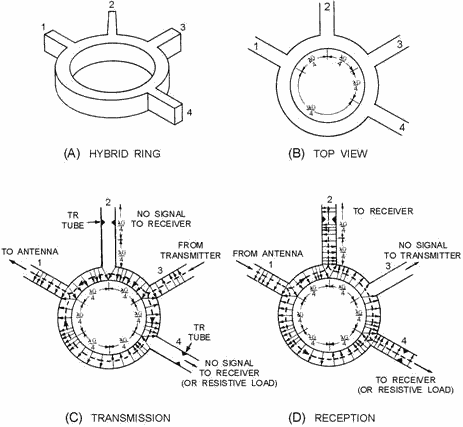
Figure 2-22. - Hybrid-ring duplexer. During transmission the E field from the transmitter enters arm 3 and divides into two fields 180
degrees out of phase. One field moves clockwise around the ring and the other moves counterclockwise. The two
fields must be 180 degrees out of phase at the entrance of an arm to propagate any energy down the arm. The field
moving clockwise from arm 3 ionizes the TR tube in arm 4, and the energy is blocked from the receiver. The TR tube
reflects a high impedance equivalent to an open circuit. This high impedance prevents any energy from entering the
receiver - even though the two fields are out of phase at the entrance to arm 4. The field moving counterclockwise
from arm 3 ionizes the TR tube in arm 2, which reflects a short circuit back to the ring junction. No energy is
sent to the receiver, however, because the fields arriving at arm 2 are in phase. The clockwise and
counterclockwise fields arrive at arm 1 out of phase by 180 degrees. They are then propagated through the arm to
the antenna. During reception, the relatively weak field from the antenna enters arm 1 and divides at the
junction into two out-of-phase components. Neither field is sufficient to fire the TR tubes in arms 2 and 4; since
the fields arrive at these arms out of phase, energy is propagated to the receiver. The energy arriving at arm 3
is in phase and will not be coupled to the transmitter. Since the operation of the arms of a hybrid ring is the
same as the operation of E-type waveguide T-junctions, you may find it helpful to review NEETS, Module 11,
Microwave Principles. 2-29
Q30. The actions of the TR and ATR circuits depend on the impedance characteristics of what length of
transmission line? Q31. During which of the transmit or receive cycles are both the TR and ATR tubes of
a parallel- connected duplexer ionized (arcing)? Q32. In a series-connected duplexer, what tube (tr or
atr), if any, fires during the receive cycle? Q33. To propagate energy down an arm of a hybrid ring
duplexer, the two fields at the junction of the arm and the ring must have what phase relationship? RECEIVERS The energy that a distant object reflects back to the antenna in a radar system is a very small fraction of
the original transmitted energy. The echoes return as pulses of RF energy of the same nature as those sent out by
the transmitter. However, the power of a return pulse is measured in fractions of microwatts instead of in
kilowatts, and the voltage arriving at the antenna is in the range of microvolts instead of kilovolts. The radar
receiver collects those pulses and provides a visual display of object information. Information about the
position of the object is present visually when the reception of an echo causes the movement or appearance of a
spot of light on a cathode-ray tube (crt). The crt requires a signal on the order of at least several volts for
proper operation and will not respond to the high frequencies within a return pulse. Therefore, a receiver
amplifier and detector must be used that are capable of producing a visible indication on the cathode-ray tube
under the following conditions: (1) when the input signal to the amplifier is in the form of pulses of extremely
high-frequency, (2) the amplitude of the pulses is in the microvolt range, and (3) the pulses last for only a few
microseconds. The radar receiver evolved directly from the simple radio receiver. The radar receiver
operates on exactly the same principles as the radio receiver. However, the overall requirements and limitations
of a radar receiver differ somewhat from those of a radio receiver because of the higher frequencies involved and
the greater sensitivity desired. In studying the radar receiver, we will first examine the overall
requirements of a radar receiver. Second, we will examine a typical radar receiver that satisfies these
requirements. Finally, we will discuss the individual components of the receiver.
Radar RECEIVER REQUIREMENTS The following characteristics determine the design
requirements of an effective radar receiver: • Noise • Gain • Tuning • Distortion •
Blocking 2-30
| - |
Matter, Energy,
and Direct Current |
| - |
Alternating Current and Transformers |
| - |
Circuit Protection, Control, and Measurement |
| - |
Electrical Conductors, Wiring Techniques,
and Schematic Reading |
| - |
Generators and Motors |
| - |
Electronic Emission, Tubes, and Power Supplies |
| - |
Solid-State Devices and Power Supplies |
| - |
Amplifiers |
| - |
Wave-Generation and Wave-Shaping Circuits |
| - |
Wave Propagation, Transmission Lines, and
Antennas |
| - |
Microwave Principles |
| - |
Modulation Principles |
| - |
Introduction to Number Systems and Logic Circuits |
| - |
- Introduction to Microelectronics |
| - |
Principles of Synchros, Servos, and Gyros |
| - |
Introduction to Test Equipment |
| - |
Radio-Frequency Communications Principles |
| - |
Radar Principles |
| - |
The Technician's Handbook, Master Glossary |
| - |
Test Methods and Practices |
| - |
Introduction to Digital Computers |
| - |
Magnetic Recording |
| - |
Introduction to Fiber Optics |
| Note: Navy Electricity and Electronics Training
Series (NEETS) content is U.S. Navy property in the public domain. |
|



















